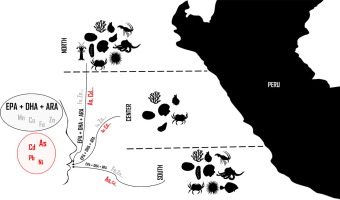当前位置:
X-MOL 学术
›
Food Chem.
›
论文详情
Our official English website, www.x-mol.net, welcomes your
feedback! (Note: you will need to create a separate account there.)
Marine species as safe source of LC-PUFA and micronutrients: Insights in new promising marine food in Peru.
Food Chemistry ( IF 8.5 ) Pub Date : 2020-04-01 , DOI: 10.1016/j.foodchem.2020.126724 I Loaiza 1 , M De Troch 2 , G De Boeck 3
Food Chemistry ( IF 8.5 ) Pub Date : 2020-04-01 , DOI: 10.1016/j.foodchem.2020.126724 I Loaiza 1 , M De Troch 2 , G De Boeck 3
Affiliation

|
Seafood could be a promising way to supplement healthy fatty acids and trace elements to the Peruvian diet. Seafood from northern Peru was characterized with the highest relative concentrations of long-chain polyunsaturated fatty acids (LC-PUFAs), while in the center region marine species had the lowest As and Pb contents. Peruvian marine species are rich in LC-PUFAs and micro-nutrients (Cu, Fe, Mn, Zn), including species considered as potentially edible (e.g. Cycloxanthops sexdecimdentatus), but also non-edible species (e.g. Caulerpa filiformis). Nevertheless, it is crucial to consider toxic metals, e.g. As and Cd, which could pose a risk for consumers. High levels of beneficial LC-PUFAs and micro-nutrients would be taken up (up to 80% of the recommended values) when the Peruvian population would consume the estimated safe amount of seafood. Scoring species for fatty acid and metal content resulted in gastropods (e.g. Bursa ventricosa) as being the least beneficial species.
中文翻译:

海洋物种可作为LC-PUFA和微量营养素的安全来源:秘鲁新有前途的海洋食品的见识。
海鲜可能是在秘鲁饮食中补充健康脂肪酸和微量元素的一种有前途的方式。来自秘鲁北部的海鲜的特征是长链多不饱和脂肪酸(LC-PUFAs)的相对浓度最高,而在中部地区海洋物种的As和Pb含量最低。秘鲁海洋物种富含LC-PUFA和微量营养元素(铜,铁,锰,锌),包括被认为具有潜在可食用性的物种(例如Cycloxanthops sexdecimdentatus),但也有非食用物种(例如Caulerpa filiformis)。但是,考虑有毒金属(例如砷和镉)对消费者构成风险至关重要。当秘鲁人口将消耗估计安全量的海产品时,将吸收大量有益的LC-PUFA和微量营养素(最高为推荐值的80%)。
更新日期:2020-04-03
中文翻译:

海洋物种可作为LC-PUFA和微量营养素的安全来源:秘鲁新有前途的海洋食品的见识。
海鲜可能是在秘鲁饮食中补充健康脂肪酸和微量元素的一种有前途的方式。来自秘鲁北部的海鲜的特征是长链多不饱和脂肪酸(LC-PUFAs)的相对浓度最高,而在中部地区海洋物种的As和Pb含量最低。秘鲁海洋物种富含LC-PUFA和微量营养元素(铜,铁,锰,锌),包括被认为具有潜在可食用性的物种(例如Cycloxanthops sexdecimdentatus),但也有非食用物种(例如Caulerpa filiformis)。但是,考虑有毒金属(例如砷和镉)对消费者构成风险至关重要。当秘鲁人口将消耗估计安全量的海产品时,将吸收大量有益的LC-PUFA和微量营养素(最高为推荐值的80%)。











































 京公网安备 11010802027423号
京公网安备 11010802027423号